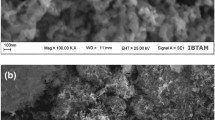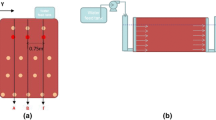Abstract
Several studies related to zero-valent iron (ZVI), which is employed for water remediation, have been made during the last years. It was found in the literature that the tests made with ZVI in situ, especially for groundwater remediation, were performed using ZVI and nano zero-valent iron (nZVI) as well. Particles usually are used like a “trench-and-fill” installation. In this arrangement, ZVI or nZVI is disposed in the contaminated areas, applied alone or mixed with other materials. The aim of the current work is to evaluate the use of nZVI, which is synthesized in laboratory, for copper ion removal in aqueous solution. The present study will serve like a base focusing, in a future stage, on the use of nZVI on groundwater remediation. For this purpose, commercial ZVI particles were also tested in order to compare the removal behavior. During this study, a relation between the solution characteristic (pH, ion concentration) and the surface purity of the iron particles was found. This relation generally is not reported in the literature. Finally, the copper removal was satisfactory with ZVI and nZVI.







Similar content being viewed by others
References
Bennett, P., He, F., Zhaob, D., Aiken, B., & Feldman, L. (2010). In situ testing of metallic iron nanoparticle mobility and reactivity in a shallow granular aquifer. Journal of Contaminant Hydrology, 116, 35–46.
Boparai, H., Joseph, M., & O’carroll, D. (2011). Kinetics and thermodynamics of cadmium ion removal by adsorption onto nano zerovalent iron particles. Journal of Hazardous Materials, 186, 458–465.
Boujelben, N., Bouzid, J., & Elouear, Z. (2009). Adsorption of nickel and copper onto natural iron oxide-coated sand from aqueous solutions: study in single and binary systems. Journal of Hazardous Materials, 163, 376–382.
Çelebi, O., Üzüm, Ç., Shahwan, T., & Erten, H. N. (2007). A radiotracer study of the adsorption behavior of aqueous Ba2+ ions on nanoparticles of zero-valent iron. Journal of Hazardous Materials, 148, 761–767.
Di Natale, F., Di Natale, M., Greco, R., Lancia, A., Laudante, C., & Musmarra, D. (2008). Groundwater protection from cadmium contamination by permeable reactive barriers. Journal of Hazardous Materials, 160, 428–434.
Dickinson, M., & Scott, T. B. (2010). The application of zero-valent iron nanoparticles for the remediation of a uranium-contaminated waste effluent. Journal of Hazardous Materials, 178, 171–179.
Huang, Y., Hsueh, C., Cheng, H., Su, L., & Chen, C. (2007). Thermodynamics and kinetics of adsorption of Cu(II) onto waste iron oxide. Journal of Hazardous Materials, 144, 406–411.
Kairies, C. L., Capo, C. L., & Watzlaf, G. R. (2005). Chemical and physical properties of iron hydroxide precipitates associated with passively treated coal mine drainage in the bituminous regions of Pennsylvania and Maryland. Applied Geochemistry, 20, 1445–1460.
Kanel, S. R., Grenèche, J., & Choi, H. (2006). Arsenic(V) removal from groundwater using nano scale zero-valent iron as a colloidal reactive barrier material. Environmental Science & Technology, 40, 2045–2050.
Kwon, J., Yun, S., Lee, J., Kim, S., & Jo, H. (2010). Removal of divalent heavy metals (Cd, Cu, Pb, and Zn) and arsenic(III) from aqueous solutions using scoria: kinetics and equilibria of sorption. Journal of Hazardous Materials, 174, 307–313.
Li, L., & Benson, C. H. (2010). Evaluation of five strategies to limit the impact of fouling in permeable reactive barriers. Journal of Hazardous Materials, 181, 170–180.
Li, X. Q., & Zhang, W. X. (2006). Iron nanoparticles: the core−shell structure and unique properties for Ni(II) sequestration. Langmuir, 22, 4638–4642.
Li, X. Q., & ZHang, W. X. (2007). Sequestration of metal cations with zerovalent iron nanoparticles—a study with high resolution X-ray photoelectron spectroscopy (HR-XPS). Journal of Physical Chemistry C, 111, 6939–6946.
Liendo, M. A., Hidalgo, G. N., Sampaio, C. H., & Heck, N. C. (2012). Synthesis of ZVI particles for acid mine drainage reactive barriers: experimental and theoretical evaluation. Journal of Materials Research and Technology, 1, 75–79.
Martini, E. M., & Muller, I. L. (1999). Passivation of iron in solutions containing borate using rotating ring-disc measurements. Journal of the Brazilian Chemical Society, 10, 505–511.
Matthew, B. J., Ptacek, C. J., Blowes, D. W., & Gould, W. D. (2008). Zero-valent iron and organic carbon mixtures for remediation of acid mine drainage: batch experiments. Applied Geochemistry, 23, 2214–2225.
Nurmi, J. T., Tratnyek, P. G., Sarathy, V., Baer, D. R., Amonette, J. E., Pecher, K., et al. (2005). Characterization and properties of metallic iron nanoparticles: spectroscopy, electrochemistry, and kinetics. Environmental Science & Technology, 39, 1221–1230.
O’Carroll, D., Sleep, B., Krol, M., Boparai, H., & Kocur, C. (2013). Nanoscale zero valent iron and bimetallic particles for contaminated site remediation. Advances in Water Resources, 51, 104–122.
Rao, P., Mak, M. S., Liu, T., Lai, K. C., & Lo, I. M. (2009). Effects of humic acid on arsenic(V) removal by zero-valent iron from groundwater with special references to corrosion products analyses. Chemosphere, 75, 156–162.
Sasaki, K., Blowes, D. W., Ptacek, C. J., & Gould, W. D. (2008). Immobilization of Se(VI) in mine drainage by permeable reactive barriers: column performance. Applied Geochemistry, 23, 1012–1022.
Sen, T. K., Mahajan, S., & Khilar, K. (2002). Adsorption of Cu2+ and Ni2+ on iron oxide and kaolin and its importance on Ni2+ transport in porous media. Colloids and Surfaces A: Physicochem. Engineering Aspects, 211, 91–102.
Shih, Y., Hsu, C., & Su, Y. (2011). Reduction of hexachlorobenzene by nanoscale zero-valent iron: kinetics, pH effect, and degradation mechanism. Separation and Purification Technology, 76, 268–274.
Sun, Y. P., Li, X. Q., Cao, J., Zhang, W. X., & Wang, H. P. (2006). Characterization of zero-valent iron nanoparticles. Advances in Colloid and Interface Science, 120, 47–56.
Üzüm, Ç., Shahwan, T., Eroğlu, A. E., Lieberwirth, I., Scott, T. B., & Hallamc, K. R. (2008). Application of zero-valent iron nanoparticles for the removal of aqueous Co2+ ions under various experimental conditions. Chemical Engineering Journal, 144, 213–220.
Üzüm, Ç., Shahwan, T., Eroğlu, A., Hallam, K., Scott, T., & Lieberwirth, I. (2009). Synthesis and characterization of kaolinite-supported zero-valent iron nanoparticles and their application for the removal of aqueous Cu2+ and Co2+ ions. Applied Clay Science, 43, 172–181.
Wang, Q., Qian, H., Yang, Y., Zhang, Z., Naman, C., & Xu, X. (2010). Reduction of hexavalent chromium by carboxymethyl cellulose-stabilized zero-valent iron nanoparticles. Journal of Contaminant Hydrology, 114, 35–42.
Xiaoshu, L., Jiang, X., Guangming, J., Jie, T., & Xinhua, X. (2012). Highly active nanoscale zero-valent iron (nZVI)–Fe3O4 nanocomposites for the removal of chromium(VI) from aqueous solutions. Journal of Colloid and Interface Science, 369, 460–469.
Yan, W., Herzing, A., Kiely, C., & Zhang, W.-X. (2010). Nanoscale zero-valent iron (nZVI): aspects of the core-shell structure and reactions with inorganic species in water. Journal of Contaminant Hydrology, 118, 96–104.
Yang, J., Cao, L., Guo, R., & Jia, J. (2010). Permeable reactive barrier of surface hydrophobic granular activated carbon coupled with elemental iron for the removal of 2,4-dichlorophenol in water. Journal of Hazardous Materials, 184, 782–787.
Zhang, W. X. (2003). Nanoscale iron particles for environmental remediation: an overview. Journal of Nanoparticle Research, 5, 323–332.
Acknowledgments
We gratefully acknowledge the financial support we received from CNPq, FAPERGS, and CAPES.
Author information
Authors and Affiliations
Corresponding author
Rights and permissions
About this article
Cite this article
Liendo, M.A., Navarro, G.E. & Sampaio, C.H. Nano and Micro ZVI in Aqueous Media: Copper Uptake and Solution Behavior. Water Air Soil Pollut 224, 1541 (2013). https://doi.org/10.1007/s11270-013-1541-1
Received:
Accepted:
Published:
DOI: https://doi.org/10.1007/s11270-013-1541-1




